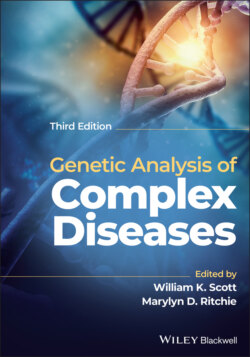Читать книгу Genetic Analysis of Complex Disease - Группа авторов - Страница 79
Example Using Correlation Coefficients to Calculate Heritability
ОглавлениеIn a large study that assessed the genetic contribution to normal variation of pulmonary function, Wilk and colleagues (2000) calculated familial correlations for spouses, parent–offspring pairs, and siblings from 455 Caucasian families for forced expiratory volume (FEV1; a measure of airflow), forced vital capacity (FVC; a measure of lung volume), and the ratio of FEV/FVC and using formula 3.6, obtained heritability estimates for the three traits (Table 3.4).
Correlations for a trait among monozygotic and dizygotic twins can also be used to calculate heritability:
(3.7)
Heritability estimates can be quite useful for data mining of a phenotype prior to initiating a genome scan. For example, if several phenotypic measures for a condition have been collected, heritability estimates may provide guidance as to which of those measures will be most useful for genetic analysis. That is, those phenotypes with the highest h2 values should be prioritized for analysis.
Table 3.4 Familial correlation and heritability estimates of pulmonary function.
Source: Wilk et al. (2000, table II).
| Trait | r sib | r p‐o | r sp | h 2 |
|---|---|---|---|---|
| FEV1 | 0.259 | 0.239 | −0.067 | 0.52 |
| FVC | 0.257 | 0.242 | −0.135 | 0.54 |
| FEV1/FVC ratio | 0.27 | 0.19 | 0.071 | 0.45 |
With the advent of Genome‐Wide Association Study (GWAS), the concept of “missing heritability” was coined to describe the difference between the estimated heritability and the amount of heritability attributable to genome‐wide significant loci detected through GWAS (Manolio et al. 2009). From this observation, methods to estimate heritability using genome‐wide SNP data emerged such that one could calculate the “SNP heritability,” suggesting that additional SNP loci not meeting genome‐wide significance contribute to the missing heritability. The most widely used of these methods include genomic‐relatedness‐matrix restricted maximum likelihood (GREML) (Yang et al. 2010) which is implemented in GCTA software (Yang et al. 2011), linkage disequilibrium score regression (LDSR) (Bulik‐Sullivan et al. 2015), and LD‐adjusted kinships (LDAK) (Speed et al. 2017). A good review of genome‐wide heritability estimation can be found in Hall and Bush (2016).
